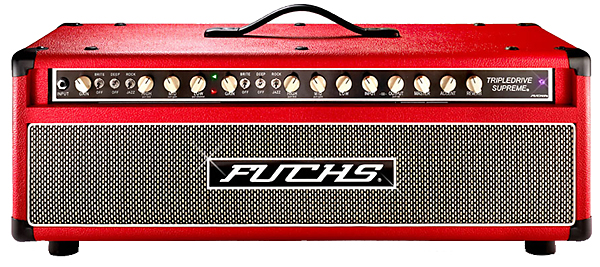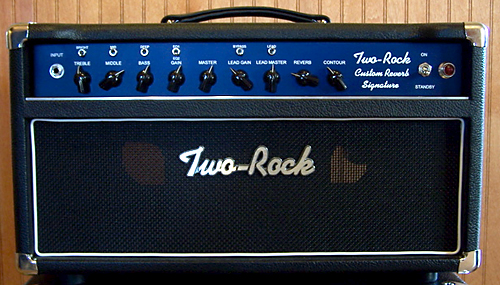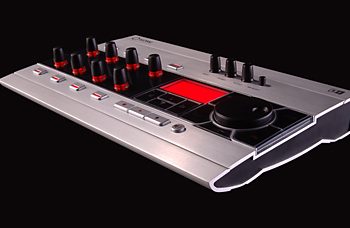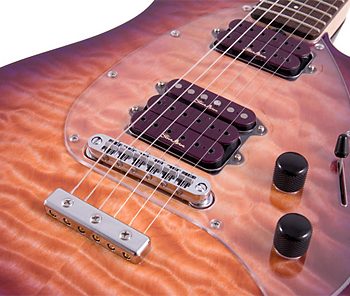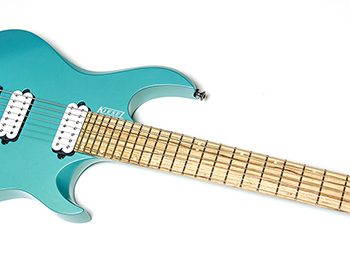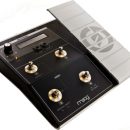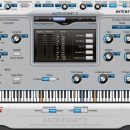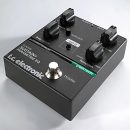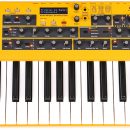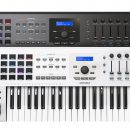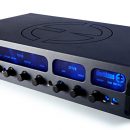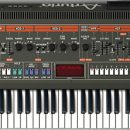Great tone and the Holy Grail – two things people have sought throughout the ages. Fortunately, if you can play well and have a lot of money, the former can be obtained, though we’re still working on the latter. And while great tone can certainly be found for less money than a Fuchs Tripledrive Supreme, you won’t get to claim boutique amp bragging rights. But just what do those rights get you?
In the case of the TDS-150, you get a very capable, extremely powerful (and loud), hand-built, three-channel tube amplifier with tone that will surely make your friends weep with envy, even if their names end with Clapton, King, Vaughn, or Johnson. You can also speak directly with the builder, master amp craftsman Andy Fuchs, to see about any needed customizations for your prized tone machine, just in case his idea of “sounds good enough for me” doesn’t sound exactly like your vision of great tone.
| Category | Value | Rating |
| Features | 20% | |
| Usability | 25% | |
| Sound | 25% | |
| Documentation & Support | 10% | |
| Price | 20% | |
| OVERALL RATING = 3.0 3.6 stars or better: Outstanding, WIHO Award 3 stars or better: Worth considering 2 stars or better: Suited to specific needs 1 star or less: Not recommended |
||
The TDS-150 is a mid-gain (by today’s standards) amp capable of producing tones ranging from the sweetest bell-like cleans to blues tones the masters would revel in, to hard rock tones that have the essence of Seventies and Eighties metal (but tightened up, refined, and superbly enhanced) – no matter what you dial into it, you will not be disappointed by the tone.
There are some quirks to the user interface that we found less than ideal (sometimes downright annoying), but our love of the tone routinely trumped the interface concerns we may have had. If anyone ever told you that money can’t buy happiness, we suspect they never had the chance to play through a Fuchs amplifier.
Features
The Fuchs TDS-150 is well stocked in the features department, starting with five 12AX7 preamp tubes and Four 6550 power tubes (like 6L6, but rated for more power). There are connection jacks for your choice of speaker cabinets rated at four, eight, or sixteen ohms, but you can only connect one speaker cabinet to the head at a time (surprising, given so much power, that you can’t connect two 4x12 cabinets). Lower-wattage versions of the TDS are available, using 6L6 or 6V6 tubes depending on the power rating, but are otherwise the same feature-wise.
The TDS amps all feature three channels. Channels 1 (Clean) and 2 (Mean) each have dedicated tone controls, while the third channel (Scream) shares tone controls with Channel 2 (and contrary to the Fuch’s marketing description is nearly identical to that channel). Each channel has independent Volume and Gain controls, with the exception of Channel 1 only having a gain control (which should be more aptly named Volume since it’s so hard to make the channel break up, but more on that later).
Each channel has switches for Bright, which boosts the top end; Deep, which boosts the low end; and a Jazz/Rock switch that changes the overall frequency response from flat to reverse scooped. Channel 3 shares its switch settings with Channel 2, though, so you can’t customize the tones from Channel 2 to 3 other than the Gain and Volume.
There are controls for a Mid Shift on each channel, too, taking your High (treble) settings and shifting the range of boosted frequencies lower into the midrange territory.
A Gain Boost feature pulls the tone controls out of each channel, resulting in more or less boosting of the guitar signal depending on how you may have adjusted the High, Mid, and Low knobs on the two channels. If your tone controls are virtually flat, you won’t hear any appreciable difference in volume when engaging the boost, whereas if you’ve cut some bass and boosted some mids or treble, you may hear a significant level change.
Additionally, Channels 2/3 have an Accent control that, according to the TDS-150 documentation, “reduces negative feedback at higher frequencies.” We found that it also does just the opposite – a very useful and creative feature!
The tube-buffered effects loop is switchable for parallel or series operation, has independent controls for both send and return levels, and also features a Trim switch to further ensure that you can interface the amp with any pedals or rack gear in your collection. The loop can’t be removed from the signal path, though, so if you don’t plan to use it, make sure that it’s set for parallel operation or you won’t hear any sound from the amp.
The onboard Reverb is an Accutronics long decay, six-spring device. Unfortunately, there is no direct On/Off control for the Reverb – you have to rotate the level completely counter-clockwise, which eliminates almost all of the reverb from the signal path.
Construction is very solid, featuring aircraft-grade aluminum inside a solid wood, tolex-covered case, hand wiring, regulated and buffered power (for low noise), and an internal fan to keep things cool.
The supplied (for testing) foot controller has been upgraded from earlier models to use a standard Ethernet RJ-45 cable for connectivity. We’re starting to see this on more guitar gear and welcome the change from proprietary (and costly) interface cables. There are six buttons that enable you to select between the three channels, apply the Mid Boost, and apply Gain Boost, but the controller lacks control for the Reverb On/Off.
Given that this monster packs 150 Watts of power, we would have liked to see the inclusion of one (or more) lower-power options.
Usability
Basic settings for each channel were a simple affair to adjust – a few switches for tonal preferences, some EQ knobs, Gain and Volume, etc., and we loved the flexible controls for the effects loop. But overall, operationally, the TDS-150 takes some getting used to.
Many knobs have a push-pull capability that isn’t directly related to the primary knob feature, while those secondary features are accessible from the foot controller. For example, some of the EQ knobs activate the Mid Shift and Gain Boost features, while the Low knob on Channel 1, when pulled, switches you to Channel 2. Besides the awkward functionality, switching channels and features this was is likely to leave you messing up your EQ settings since the knobs are extremely smooth and sensitive to the touch. Fortunately, you can make all of these changes from the foot controller.

This leads to another frustration with the TDS-150’s interface – the foot controller. From left to right, the six switches are:
- Mid Shift for Channel 1
- Gain Boost for Channel 1
- Switch from Channel 1 to Channel 2
- Switch between Channel 2 and Channel 3
- Mid Shift for Channel 2/3
- Gain Boost for Channel 2/3
We prefer three separate channel switches for a three-channel amplifier, and on most modern amps, channel switches are the first switches on a foot controller. Placing them in the middle of the button layout was counter-intuitive, and because each button has a light when activated, you only know that you’re on Channel 1 when there are no lights over the middle two buttons, and you only know that Channel 3 is engaged when lights are over both of the middle buttons.
There was no footswitch for turning the Reverb On/Off, though the amp has an external jack for connecting a dedicated On/Off switch for that purpose. And while there were switches for the boost feature, we prefer a traditional boost feature that provides a consistent, user-defined amount of gain when applied.
We appreciated that the control knobs were recessed on the front panel, reducing the likelihood of damage the first (and last) time your roadie drops the head on its face, but we were frustrated (yes, we’re always this picky) by the dense layout of knobs. With the controls labeled below the knobs (rather than above them), it was nearly impossible to read them unless looking straight on and at eye level. The dense arrangement with poor labeling made it very easy to accidentally turn up the Volume instead of Gain, for example.
Sound
We could tell you that the Fuchs TDS-150 doesn’t sound any better than your run-of-the-mill production-line amplifier, but that would be completely insane and you’d never believe another word we published. To find one word that adequately sums up the sonic character of the TDS, we’d have to settle on… sweet!
The sound of the TDS-150 can be characterized as clean, focused, and transparent, and it is capable of generating a wide range of sounds that will suit everyone from the session player down in Nashville to the New York City blues cat to the Los Angeles hard rocker. Seekers of pristine boutique tube tone need look no further, and our gripes about the sometimes-awkward interface melt into the background once you start playing this incredible tone machine.
We tested the TDS-150 with both a Fender Stratocaster equipped with single coil Vintage Noiseless pickups and an Ibanez RG-series mahogany-body guitar customized with DiMarzio humbuckers, through a Mesa/Boogie Rectifier Traditional 4x12 loaded with Celestion 60W Vintage 30 speakers as well as a Marshall 1936A 2x12 loaded with Celestion G12T75 speakers.
When paired to these very different guitars, the TDS-150 responded like two very different amps. Really, the major sonic differences observed had more to do with the transparency of the amp. As opposed to many amps that color your sound with cleverly scooped EQ curves, the TDS-150, depending on the voicing you select, presents studio quality cleanliness with a nearly flat frequency curve – even on the overdriven channels! As a result, what you hear are truly the sounds of your guitars with minimal colorization from the amplifier.
We loved the clean channel with the Jazz voicing. This provided the flat frequency response we’re gushing about, and it was clean no matter how loud we attempted to turn the amp up. With 150 Watts of power, there’s more headroom than you’ll ever need on this channel. To add more depth to our Stratocaster tone, the Deep switch filled out the sound with a fatter and rounder bottom end, but it was too much when used with the humbucker-equipped guitar.
Selecting the Rock voicing on the first channel significantly alters the tone from the Jazz setting, boosting the mids and lows, and adding some gain. This voicing provides more “typical” Marshall-esque clean tones, and you can get some preamp tube distortion happening when you start to crank up the gain, but still, it’s clean, and it’s not easy to break up this channel unless you place an overdrive pedal in front of the amp.
Channel two and three are nearly identical, and they share a common set of tone controls. The only independent controls for these two channels are their Gain and Master Volume, but internally, the third channel has very slightly altered EQ that is (according to builder Andy Fuchs) slightly tighter in the low end for use as a solo/lead setting, though we didn’t notice any particular difference in our playing.
If you love hard rock and mid-gain (by today’s standards) metal tones that fall somewhere between Marshall and Mesa/Boogie (but different than both), look no further than this amp. It will rock you.
The range of tones available in the high-gain channels were extensive. Our Stratocaster’s neck pickup howled the blues at middle gain settings, while our RG screamed classic hard rock and metal tones from its bridge pickup and gain settings in the 3:00 – 4:00 range. It dished out a huge palette of heavy tones that could easily be used to comp 70s and 80s metal music, but its tighter bottom end made it well suited for playing modern hard rock/emo music, too.
The Accent control is fairly unique. While our first thought was, “Oh, it’s probably just like a Presence knob,” experimentation quickly revealed that it was most certainly not that kind of a tone control – it was something a whole lot more exciting. The Accent control provides control over the amount of negative feedback generated by the amp!
At lower settings, feedback was more controlled and slower to generate upon sustaining notes, while turning the knob to 12:00 or higher brought on feedback and harmonic squeals much more aggressively. Being able to custom-tailor feedback to our individual taste and style was a wickedly cool feature.
Flipping the SAG switch on the rear of the amp changes the response of the amplifier to distort faster, similar to tube rectification, though rectification in the TDS-150 is solid state. At one point, with the SAG switch engaged, while one of our editors faithfully performed “Eruption” for nostalgic purposes, we marveled at the gorgeous tone – imagine the classic “brown” sound tone-wise, but without any noise and a tighter low end. Nice, and we didn’t even have EL-34 tubes!
We have to further comment on just how clean sounding this amp is, especially with high-gain settings. The bass response is extremely tight and focused, and we heard details in chord voicings that are completely lost when playing on cheaper amplifiers. This is an amp for a competent player – it will let you hear mistakes with greater clarity where other amps may have been more forgiving. And the clarity of notes in the lower registers would also make this a great amp for use with seven-string or baritone guitars, though we didn’t test with these instruments.
And as for you country folks and alt-rockers – you’re not left out of the fun with this amp, either. We found that the range of tones available with the gain at lower settings, especially when played with a single-coil equipped guitar, were well suited to every style of playing we through at the amp.
The channels each feature a Mid boost, selectable from the footswitch. For most rock and blues playing, we found limited value in this feature, but for country-style playing through our Strat, it made for a nice tone shift without specifically altering our volume.
The third channel sounded virtually identical to the second, and if you don’t need the variety of tones that a low-gain setting and a high-gain setting might provide between Channel 2 and Channel 3, you could dial in a similar amount of gain as Channel 2, add some additional volume, and use it as a traditional solo/lead channel.
The onboard reverb sounded beautiful, and we loved how its character changed based upon the reverb level. At lower settings (below 9:00), the reverb sat tightly behind our notes, mid-range settings softened the attack of our playing and providing a rounder, warm, reverb, and higher settings (past 12:00) were just the stuff of extreme effects – nice sounding, but not particularly useful for typical playing.
The onboard reverb was all the effect you might need to find yourself in love with the TDS-150’s tone, but why stop there when you’ve got a great effects loop? Effects-lovers that we are, we placed a TC Electronic G-Major in the loop (set for series operation) and spent some time getting our levels set. Improper input/output levels on the amp and the G-Major can result in significant “tone suckage” as we initially experienced, but once dialed in properly, our classic chorus, delay, and compression settings took the Fuchs tone over the top, properly adding our effects behind the notes without detracting from the amplifier’s gorgeous tone.
Documentation and Product Support
The Operations Manual provided many of the basics but wasn’t entirely accurate. The amp has been revised since the last printing of the instructions, and Andy informed us that the instructions are in the midst of revision.
Overall, though, it did an adequate job of describing all of the functions and even provided some information related to biasing the tubes.
Fuchs amplifiers come with a five-year warranty, but note that the warranty is nullified if the amp is used with a power attenuator.
Price
The Fuchs TDS-150 head is $4,195. Combo versions featuring one or two Eminence Wizard 12” speakers are priced at $4,495 and $4,695. The six-button Artist Plus footswitch costs an additional $595.
Boutique amps carry large price tags, but you do get a hand-built product manufactured in small quantities, helping to ensure that your tone is really your tone and not the same tone as every other player on the block.
If great tone is worth any price to you, the TDS-150 certainly won’t disappoint, and it’s not even the most expensive amp on the block. We do feel, though, that at these prices, the footswitch should be included.
Other Comments
Want to take a virtual visit to the Fuchs Audio Technology factory? Click here to learn more about Andy and his great amplifier company.
Contact Information
Fuchs Audio Technology
www.fuchsaudiotechnology.com

